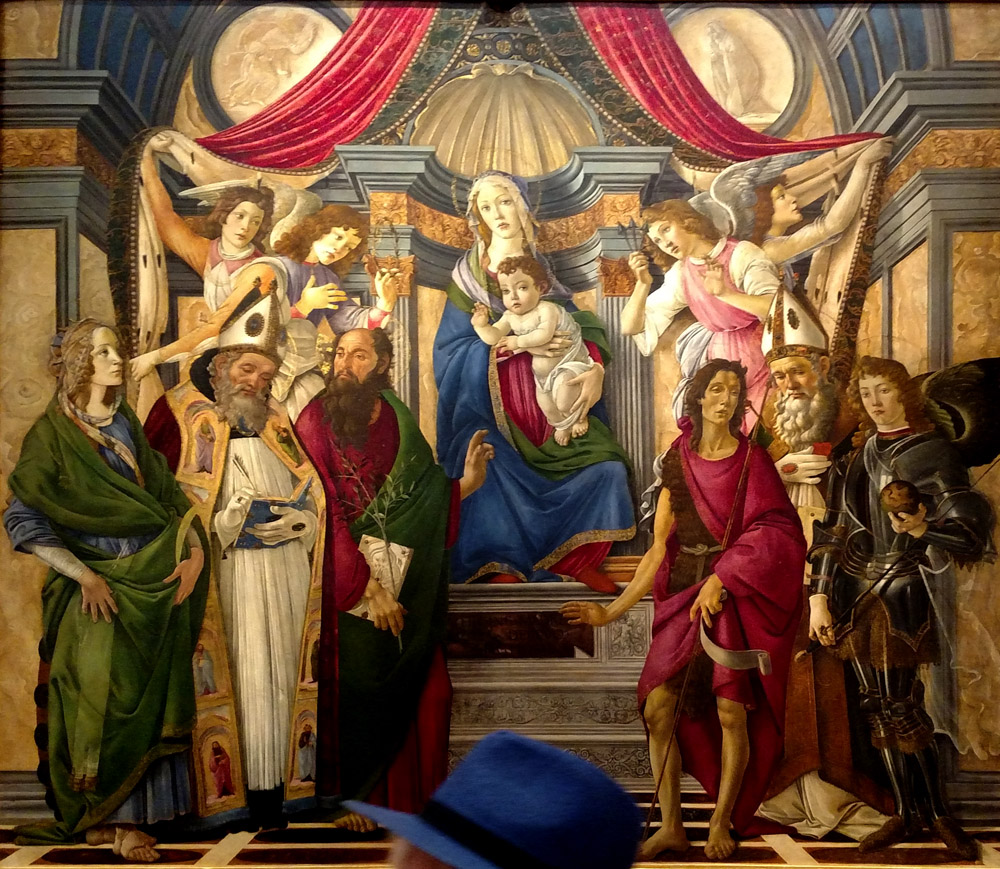Sandro Botticelli, Madonna and Child with Angels and Saints

Florence, 1487-88
Tempera on wood
Painted for the Church of San Bernabe, Florence
Uffizi Gallery, Florence, Italy
Draping a bit of cloth over the child's genitals, the artist retracts a bit from the 15th-century practice of showing him naked. Mary, the only figure adorned with a halo, wears her typical blue mantle and red robe. The colors of her purple veil and green scarf could possibly refer to the liturgical colors worn in the penitential seasons and the time after Pentecost respectively.1
Two angels stand left and right of the throne. One offers the child three nails; the other, a crown of thorns. These refer of course to Christ's passion and death on the cross, the purpose of his mission to the world. In other images the point is usually expressed through gentler symbolism, such as a swallow or bunch of grapes in the child's hand.
In the foreground, the saint on the far left is identified by the gallery's label as Catherine of Alexandria. The figure has a small palm branch and a crown but no attribute specific to St. Catherine. The bishop next to her is St. Augustine, identified by his elaborately hemmed cape.
The next figure is identified by the gallery's label as St. Barnabas, the patron saint of the church for which this piece was painted. He holds a book and an olive branch. Books are common in portraits of saints, so this one may be just iconographical boilerplate, but a physical book does figure at one point in the apocryphal Acts of Barnabas (945): "And Barnabas had received documents from Matthew, a book of the word of God, and a narrative of miracles and doctrines. This Barnabas laid upon the sick in each place that we came to, and it immediately made a cure of their sufferings."
As for the olive branch, I have studied a great many images of St. Barnabas and have found no other that uses an olive branch as an attribute. Nor is such an object mentioned in the Golden Legend, in Acts, or in the paleo-Christian apocrypha. The Epistle of Barnabas does have a cryptic reference to hyssop, which resembles olive somewhat; but that reference is so confusing and the branch in the painting is so obviously olive that it cannot be the explanation. That leaves Acts 15, in which the Apostles in Jerusalem send Paul and Barnabas to Antioch with a message that resolves a dispute that had arisen there. Perhaps the olive branch references their mission of peace.
On the right side of the foreground, the first of the saints is John the Baptist in the traditional camel-skin tunic and carrying a banderole. Though it has no writing on it, the banderole is most likely a reference to his exclamation, "Behold the Lamb of God" (John 1:29). Those words are often seen on banderoles in portraits of this saint.
Next are St. Ignatius of Antioch, identified by the gallery label but not by any attributes other than his mitre, and St. Michael the Archangel in armor and carrying a sword and a globe. The globe is not a usual attribute of this saint.
View this image in full resolution.
Read more about portraits of the Madonna and Child.
Photographed at the Uffizi by Richard Stracke, shared under Attribution-NonCommercial-ShareAlike license.